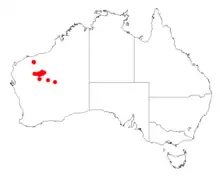Acacia intorta
Acacia intorta is a shrub or tree belonging to the genus Acacia and the subgenus Juliflorae that is endemic to arid parts of central Western Australia.
| Acacia intorta | |
|---|---|
| Scientific classification | |
| Kingdom: | Plantae |
| Clade: | Tracheophytes |
| Clade: | Angiosperms |
| Clade: | Eudicots |
| Clade: | Rosids |
| Order: | Fabales |
| Family: | Fabaceae |
| Subfamily: | Caesalpinioideae |
| Clade: | Mimosoid clade |
| Genus: | Acacia |
| Species: | A. intorta |
| Binomial name | |
| Acacia intorta | |
 | |
| Occurrence data from AVH | |
The tree has a gnarled appearance and typically grows to a height of 1.5 to 3 metres (5 to 10 ft) with fissured[1] and fibrous grey coloured bark. It has contorted main branches and tend to spread horizontally and has glabrous branchlets. The erect, evergreen phyllodes are straight and most often terete. The pungent, rigid phyllodes have a length of 5 to 10 cm (2.0 to 3.9 in) and a width of 1.5 to 2 mm (0.059 to 0.079 in) and are indistinctly multistriate.[2] It blooms from April to June producing yellow flowers.[1] The rudimentary inflorescences occur as flower-spikes with a length of 1 to 5 cm (0.39 to 1.97 in) and are not densely flowered. The narrowly oblong seed pods have a length of 4 to 9 cm (1.6 to 3.5 in) and a width of 5 to 8 mm (0.20 to 0.31 in). The dark brown seeds inside the pods have an elliptic to oblong shape and are 4 to 7 mm (0.16 to 0.28 in) in length.[2]
It is native to an area in the Pilbara and Goldfields regions of Western Australia with the bulk of the population found between Meekatharra and Newman where it is found on stony ridges, shape slopes and saline drainage floors where it grows in calcrete and alkaline clay soils.[1]
See also
References
- "Acacia intorta". FloraBase. Western Australian Government Department of Biodiversity, Conservation and Attractions.
- "Acacia intorta". World Wide Wattle. Western Australian Herbarium. Retrieved 11 August 2019.